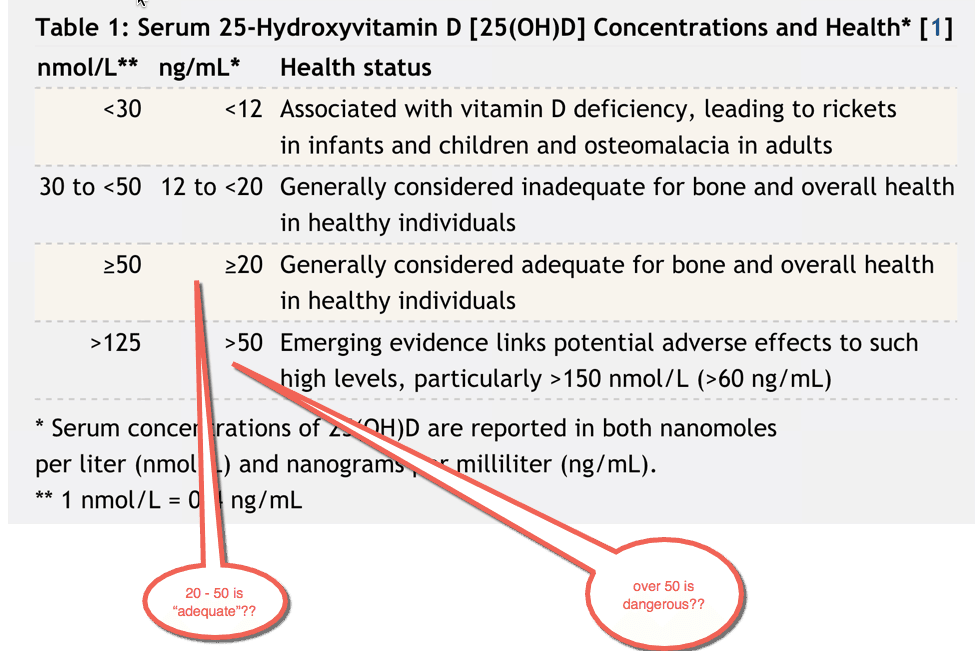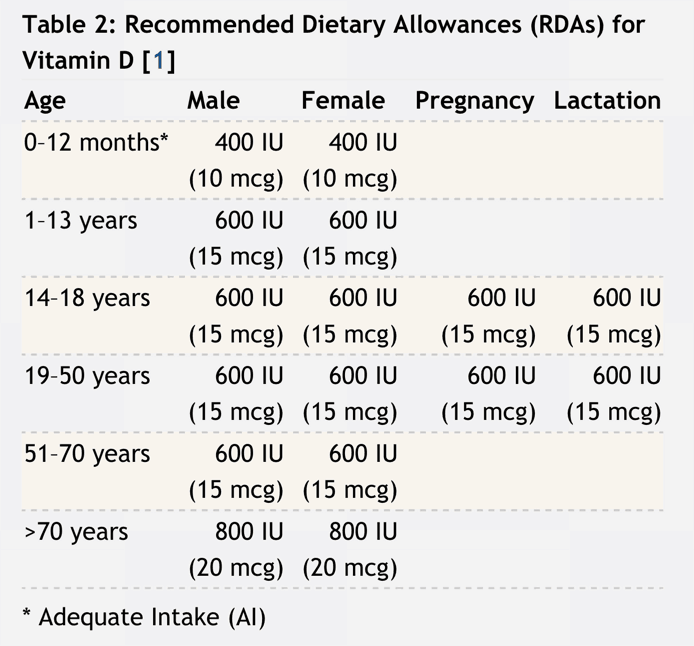
Doctors are finally getting educated on the benefits of vitamin D.
But it’s certainly coming quite late, and there’s a reason for that.
The drug companies have no interest in vitamin D.
They only have an interest in something that they can alter slightly and patent.
If drug companies can’t patent it, they can’t make nearly as much money on it, or keep it out of the hands of their competitors.
Then they push it on doctors who are so busy and overstressed that they don’t have time to really review the studies and discover the truth.
The drug companies depend on the doctors being too busy and committed to their patients so that they remain ignorant of better options.
It’s not really fair, but that’s the way it is.
So now there comes out a huge analysis of two major studies on vitamin D… and it’s a scandal.
The scandal is that they continue recommending very low vitamin D blood levels that lead to cancer and heart disease.
For instance, this National Institutes of Health chart shows the NIH current recommendations:
 HUH?
HUH?
There is NO good evidence for recommending what is essentially a vitamin D deficiency.
But that’s what the US government (and the UK government also) suggests.
They want you to keep your vitamin D down below 50.
And look how pitifully low the recommended daily allowances are:
 If I didn’t know better, I would think that the governments are in league with big Pharma are trying to make us sick by having very low vitamin D levels, so they could treat us with all sorts of drugs and care.
If I didn’t know better, I would think that the governments are in league with big Pharma are trying to make us sick by having very low vitamin D levels, so they could treat us with all sorts of drugs and care.
But I’m not that cynical, LOL!
I’m sure that once there are more quality studies, the government recommendations will increase to levels that help to prevent illnesses.
So let’s get to the study now:
This new study says that vitamin D blood levels over 50 are BETTER.
 The researchers examined over 2000 women’s health records for vitamin D levels and correlated the results with cancer.
The researchers examined over 2000 women’s health records for vitamin D levels and correlated the results with cancer.
And they found that women who have a vitamin D level over 40, or even over 50 or 60, have a three-quarters lower chance of getting cancer.
So if 1000 people out of 100,000 are diagnosed each year, those with vitamin D would only be diagnosed at a rate of 250 people out of 100,000.
That means 750 people would not get cancer because of protective vitamin D levels, and only because they didn’t listen to the government recommendations.
As the study says,
concentrations ≥40 ng/ml had a approximately 70% lower risk of cancer compared to women with concentrations <20 ng/ml.
And more may be better.
We observed the greatest decrease in risk occurring between 10 and 40 ng/ml, with additional benefit also observed at over 40 ng/ml.
As the researchers say:
Primary prevention of cancer, rather than expanding early detection or improving treatment, will be essential to reversing the current upward trend of cancer incidence worldwide.
But how do you make sure you have adequate vitamin D levels?
The only way to really know if you have adequate vitamin D is by getting a blood test.
The test is pretty simple and inexpensive and quite effective at measuring vitamin D levels.
If you get a lot of sunlight, you probably won’t need to bother with a blood test.
Sunlight is the best way of getting vitamin D.
You can always wear a hat and protect your face, but sunlight needs to touch most of your body to be effective.
A person can get 15,000 units of vitamin D in bright sunlight in just 15 minutes.
You don’t need a whole lot of time spent in the sun to reap the best health benefits.
However, the darker your skin, the more sunlight you need to generate enough vitamin D.
This difference in pigmentation may be why so many African-American people have heart problems and higher incidences of cancer.
They may not be getting enough sunlight for their skin tone.
If you can’t increase your sun exposure, there are other ways to get your vitamin D.
There are foods that can help supply your vitamin D, but this is the hard way to get enough.
Also, you can take vitamin D, orally, but make sure you take it in the right form.
You should only take vitamin D3.
You can take anywhere from 5000 to 50,000 units of D3 per day.
And when you take vitamin D it’s essential that you also take vitamin A, vitamin E, and vitamin K2.
These all go together.
And if you don’t get enough of each of these vitamins together, you may suffer from bad effects such as calcium in your arteries.
You also should make sure you have enough calcium and magnesium.
Higher vitamin D consumption will result in a greater need for calcium and magnesium, and vitamin K2 will help your body to deposit the calcium into your bones and strong teeth and jaw, for huge benefits.
Citations
Serum 25-Hydroxyvitamin D Concentrations ≥40 ng/ml Are Associated with >65% Lower Cancer Risk: Pooled Analysis of Randomized Trial and Prospective Cohort Study
http://journals.plos.org/plosone/article?id=10.1371/journal.pone.0152441
Higher levels of vitamin D correspond to lower cancer risk
https://www.sciencedaily.com/releases/2016/04/160406165254.htm
Click for more information on vitamin D, for information on Vitamins, or for more on how Vitamin D lowers cancer risk.
